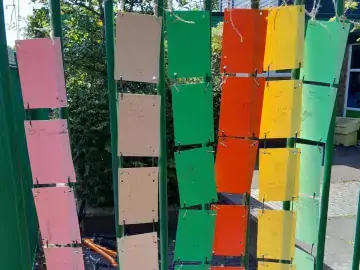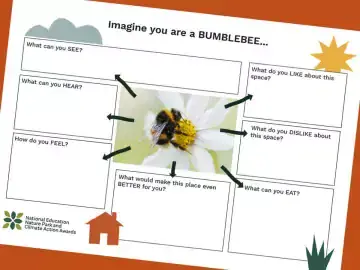
A chain from a sheet of paper
This activity, developed in dialogue with artist Harun Morrison, provides an opportunity for young people to engage in discussion and debate about nature and the environment. It acts as an entry point to discussing the importance of nature and taking action, introducing the concepts of biodiversity and ecology through discussion, creative thinking and sensory exploration.
The activity consists of a series of questions, instructions and statements, which are discussed in small groups – each question links in some way to the last, enabling learners to build upon their ideas and knowledge through each topic. By cutting and linking each question discussed, learners will end with a paper chained formed from their discussion as a visual reminder of the concepts introduced and relationships made.
Preparation
What you need
- Paper chain questions – one copy per group
- Access to plants nearby
- Access to soil - outside or in a container
- Scissors
- Glue or tape
- Pens or pencils
- Flipchart or board
- Wipes or hand washing facilities
- Optional: Pine cones and fern leaves for Q.13 – or the downloadable images for reference
- Optional: clipboards or stones to keep hold of the paper if outside
Location
Indoors or outdoors
Useful guidance
Step by step
This activity can take place indoors or outside - if outside and depending on the weather, learners may wish to use a clipboard to hold onto their paper and construct the paper chain at the end, or use small stones from outside to weigh down their paper chains as they make them.
Some instructions in the handout ask learners to engage with elements of nature such as smelling a plant or grabbing a handful of soil. Have wipes available or a hand-washing station for afterwards.
- To introduce the activity, spend some time connecting with nature to prepare learners for their discussions – Sound mapping or Creative responses to a place will help children and young people take notice of the nature around them.
Alternatively, if delivering the activity indoors, the session could begin with an open class discussion, collecting the group’s thoughts: “Why do we need nature?” “What does nature need from us?” - Hand out the paper chain worksheets – one set for each group of 2-3 learners. There is also a set of blank strips, for groups to note down their key points or answers from each question. Ask learners to work through the questions in order in their groups, cutting out each strip and creating a paper chain of their questions and answers as they go. (If learners are unfamiliar with making a paper chain, demonstrate with a couple of strips of paper. It’s a good idea to make the paper chains with text facing outwards so that the questions and answers can be read by others afterwards!)
- Encourage learners to take their time expressing their opinions and discuss each other’s ideas for each question – do you agree with each other? Why, or why not? What can you learn from each other’s perspectives? Remind learners to make a note of their discussion on one of the blank strips and add it to their chain after each question.
- Questions 8 and 21 introduce the definitions of ecology and biodiversity. Encourage groups to discuss these definitions when they reach them - Why are these topics important? Why do we study them? What can we find out by studying them?
- When learners finish their paper chain (as some groups may finish before others), invite them to share the school rules they proposed for question 19. Have a flipchart or board for learners to add their new nature-focused school rule to. After the activity has finished, gather to read your new list of school rules together – are there any you could take forward to be added to your overall school’s rules or code of conduct? How could you encourage others to abide by these rules?
Reflection
Discuss what ‘small action’ learners committed to for the environment. What could the impact be if all of these small actions added up? What could our school or community look like if everyone took a small action for nature?
Curriculum links
This activity can be used to support curriculum knowledge and skill development in citizenship, alongside enhancing nature education, with age appropriate adaptations.
What to try next

Biodiversity bar charts
Begin activity